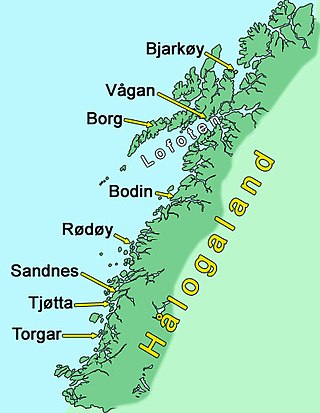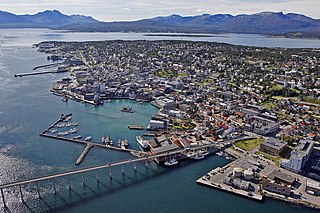
Troms is a county in northern Norway. It borders Finnmark county to the northeast and Nordland county in the southwest. Norrbotten Län in Sweden is located to the south and further southeast is a shorter border with Lapland Province in Finland. To the west is the Norwegian Sea. The county had a population of 169,610 in 2024.

Finnmark is a county in northern Norway. By land, it borders Troms county to the west, Finland to the south, and Russia to the east, and by water, the Norwegian Sea to the northwest, and the Barents Sea to the north and northeast.
Kvenland, known as Cwenland, Qwenland, Kænland, and similar terms in medieval sources, is an ancient name for an area in Fennoscandia and Scandinavia. Kvenland, in that or nearly that spelling, is known from an Old English account written in the 9th century, which used information provided by Norwegian adventurer and traveler Ohthere, and from Nordic sources, primarily Icelandic. A possible additional source was written in the modern-day area of Norway. All known Nordic sources date from the 12th and 13th centuries. Other possible references to Kvenland by other names and spellings are also discussed here.
Eric Anundsson or Eymundsson was a semi-legendary Swedish king who supposedly ruled during the 9th century. The Norse sagas describe him as successful in extending his realm over the Baltic Sea, but unsuccessful in his attempts of westward expansion. There is no near-contemporary evidence for his existence, the sources for his reign dating from the 13th and 14th centuries. These sources, Icelandic sagas, are generally not considered reliable sources for the periods and events they describe.
Emund the Old was King of Sweden from c. 1050 to c. 1060. His short reign was characterised by disputes with the Archbishopric of Bremen over church policies, and a historically debated delimitation of the Swedish-Danish border.
Ohthere of Hålogaland was a Viking Age Norwegian seafarer known only from an account of his travels that he gave to King Alfred of the Anglo-Saxon kingdom of Wessex in about 890 AD. His account was incorporated into an Old English adaptation of a Latin historical book written early in the fifth century by Paulus Orosius, called Historiarum Adversum Paganos Libri VII, or Seven Books of History Against the Pagans. The Old English version of this book is believed to have been written in Wessex in King Alfred's lifetime or soon after his death, and the earliest surviving copy is attributed to the same place and time.

Bjarmaland was a territory mentioned in Norse sagas from the Viking Age and in geographical accounts until the 16th century. The term is usually understood to have referred to the southern shores of the White Sea and to the basin of the Northern Dvina River as well as, presumably, to some of the surrounding areas. Today, those territories comprise a part of the Arkhangelsk Oblast of Russia, as well as the Kola Peninsula.
Fornjót is a jötunn in Norse mythology, and the father of Hlér ('sea'), Logi ('fire') and Kári ('wind'). It is also the name of a legendary king of "Finland and Kvenland". The principal study of this figure is by Margaret Clunies Ross.

Hålogaland was the northernmost of the Norwegian provinces in the medieval Norse sagas. In the early Viking Age, before Harald Fairhair, Hålogaland was a kingdom extending between the Namdalen valley in Trøndelag county and the Lyngen fjord in Troms county.
Faravid was a legendary King of Kvenland who is mentioned in the Icelandic Egils saga from the early 13th century. According to the saga, Faravid made an alliance with the Norwegian Thorolf Kveldulfsson to fight against Karelian invaders.
A few Icelandic sagas tell about kings that ruled in Kvenland.
Terra feminarum is a name for an area in Medieval Northern Europe that appears in Gesta Hammaburgensis Ecclesiae Pontificum by Adam of Bremen 1075 AD.

There are scattered descriptions of early Finnish wars, conflicts involving the Finnish people, some of which took place before the Middle Ages. The earliest historical accounts of conflicts involving Finnish tribes, such as Tavastians, Karelians, Finns proper and Kvens, have survived in Icelandic sagas and in German, Norwegian, Danish and Russian chronicles as well as in Swedish legends and in birch bark manuscripts. The most important sources are the Novgorod First Chronicle, the Primary Chronicle and Erik's Chronicle.
The origin of the name Kainuu has been disputed among Finnish historians and linguistics. Kainuu is a region of Finland. The reason for the controversy is the speculated connection between areas known as Kainuu and Kvenland, both historical lands in Fennoscandia.
Thorolf Kveldulfsson was the oldest son of Kveldulf Bjalfasson and brother of the Norwegian/Icelandic goði and skald Skalla-Grimr. His ancestor Hallbjorn was nicknamed "halftroll", possibly indicating Norwegian-Sami ancestry.

The Hålogaland Court of Appeal is one of six courts of appeal in the Kingdom of Norway. The Court is located in the city of Tromsø. The court has jurisdiction over the counties of Nordland, Troms, and Finnmark as well as the island territories of Jan Mayen and Svalbard. These areas constitute the judicial district of Hålogaland, which has nearly a half a million residents. This court can rule on both civil and criminal cases that are appealed from one of its subordinate district courts. Court decisions can be, to a limited extent, appealed to the Supreme Court of Norway. The court has 16 full-time judges plus a number of other support staff members. The chief judicial officer of the court is currently Monica Hansen Nylund. The court is administered by the Norwegian National Courts Administration.
Norway has two official names: Norge in Bokmål and Noreg in Nynorsk. The English name Norway comes from the Old English word Norþweg mentioned in 880, meaning "northern way" or "way leading to the north", which is how the Anglo-Saxons referred to the coastline of Atlantic Norway similar to leading theory about the origin of the Norwegian language name. The Anglo-Saxons of Britain also referred to the kingdom of Norway in 880 as Norðmanna land.

Tromsø, Romsa (Northern Sami), or Tromssa (Kven) is a city in Tromsø Municipality in Troms county, Norway. The city is the administrative centre of the municipality as well as the administrative centre of Troms county. The Diocese of Nord-Hålogaland and its Bishop are based at the Tromsø Cathedral in the city. The city is located on the island of Tromsøya which sits in the Tromsøysundet strait, just off the mainland of Northern Norway. The mainland suburb of Tromsdalen is connected to the city centre on Tromsøya by the Tromsø Bridge and the Tromsøysund Tunnel. The suburb of Kvaløysletta on the island of Kvaløya is connected to the city centre by the Sandnessund Bridge.
The name Finn is an ethnonym that in ancient times usually referred to the Sámi peoples, but now refers almost exclusively to the Finns.






